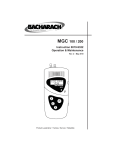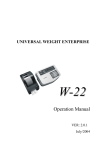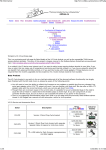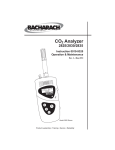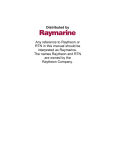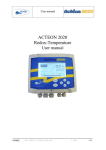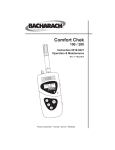Download Bacharach 3010 Specifications
Transcript
Instruction 0019-9208 N2O Monitor Model 3010 P/N 0019-7109 Operation & Maintenance Rev. 9 – May 2010 Product Leadership • Training • Service • Reliability N2O Monitor 3010 WARRANTY Bacharach, Inc. warrants to Buyer that at the time of delivery this Product will be free from defects in material and manufacture and will conform substantially to Bacharach Inc.’s applicable specifications. Bacharach’s liability and Buyer’s remedy under this warranty are limited to the repair or replacement, at Bacharach’s option, of this Product or parts thereof returned to Seller at the factory of manufacture and shown to Bacharach Inc.’s reasonable satisfaction to have been defective; provided that written notice of the defect shall have been given by Buyer to Bacharach Inc. within one (1) year after the date of delivery of this Product by Bacharach, Inc. Bacharach, Inc. warrants to Buyer that it will convey good title to this Product. Bacharach’s liability and Buyer’s remedy under this warranty of title are limited to the removal of any title defects or, at the election of Bacharach, to the replacement of this Product or parts thereof that are defective in title. THE FOREGOING WARRANTIES ARE EXCLUSIVE AND ARE GIVEN AND ACCEPTED IN LIEU OF (I) ANY AND ALL OTHER WARRANTIES, EXPRESS OR IMPLIED, INCLUDING WITHOUT LIMITATION THE IMPLIED WARRANTIES OF MERCHANTABILITY AND FITNESS FOR A PARTICULAR PURPOSE: AND (II) ANY OBLIGATION, LIABILITY, RIGHT, CLAIM OR REMEDY IN CONTRACT OR TORT, WHETHER OR NOT ARISING FROM BACHARACH’S NEGLIGENCE, ACTUAL OR IMPLIED. The remedies of the Buyer shall be limited to those provided herein to the exclusion of any and all other remedies including, without limitation incidental or consequential damages. No agreement varying or extending the foregoing warranties, remedies or this limitation will be binding upon Bacharach, Inc. unless in writing, signed by a duly authorized officer of Bacharach. Register Your Warranty by Visiting www.mybacharach.com BACHARACH® is a registered trademark of Bacharach, Inc. All other trademarks are the property of their respective owners. Copyright © 2000–2010, Bacharach, Inc., all rights reserved. A Instruction 0019-9208 N2O Monitor 3010 Contents 1.0 INTRODUCTION ...................................................................................1 1.1 General ....................................................................................... 1 1.2 Main Features ............................................................................ 1 1.3 Units of Measurement ............................................................... 2 2.0 OPERATION ...........................................................................................3 2.1 Important Note .......................................................................... 3 2.2 Switching the Monitor ON/OFF ................................................ 3 2.3 Start-Up Display ........................................................................ 4 2.4 Response Time ........................................................................... 4 2.5 Normal ppm Mode ..................................................................... 5 2.6 Time Weighted Average (TWA/twa) Mode ............................... 5 2.7 Time Weighted Average Alarm ................................................. 7 2.8 Auto-Stablization Mode ............................................................. 7 2.9 Leak Detection Mode ................................................................. 8 2.10 Pump Operation ......................................................................... 9 2.11 Data Logging .............................................................................. 9 2.12 Battery Low Display ................................................................ 10 2.13 Battery Charge Indicator ........................................................ 10 2.14 Fault Condition Warning ........................................................ 10 2.15 Powering Monitor from Charger ............................................. 11 2.16 Cross Sensitivity ...................................................................... 11 3.0 MAINTENANCE...................................................................................12 3.1 Battery Charging ..................................................................... 12 3.2 Cleaning ................................................................................... 13 3.3 Sunlight .................................................................................... 13 3.4 Servicing ................................................................................... 13 3.5 Software Version / Serial Number .......................................... 13 3.6 Factory Settings ....................................................................... 13 3.7 Zero Calibration ....................................................................... 14 3.7.1 Clean Air Calibration ................................................. 15 3.7.2 Zero Gas Calibration .................................................. 15 3.8 Gas Calibration ........................................................................ 16 4.0 PARTS & SERVICE.............................................................................17 4.1 Replacement Parts and Accessories........................................ 17 4.2 Bacharach Sales/Service Centers............................................ 18 Instruction 0019-9208 i N2O Monitor 3010 SPECIFICATIONS Range & Resolution ...........0 to 1,000 ppm N2O; 5 ppm resolution Accuracy .............................±10% of reading or ±10 ppm, whichever is greater Zero Drift ............................Typically <20 ppm over an 8 hour period with fully charged batteries and at a constant temperature (zero drift in auto-stablization mode) Battery Life ........................Up to 8 hours on one charge Battery Recharge Time ......Approx. 2 hours Sensor .................................Dual wavelength IR cell Operating Temperature .....59 to 77 °F (15 to 25 °C) Relative Humidity ..............0–99% R.H., non-condensing Dimensions .........................5.5"L x 2.6"W x 0.8"H (140 x 66 x 20 mm) Weight.................................8 oz (230 grams) Construction .......................High Impact ABS Case Case Seal ............................NEMA 12 (IP65) (Dust and water resistant) ii Instruction 0019-9208 N2O Monitor 3010 1.0 INTRODUCTION 1.1 General The Bacharach N2O Monitor 3010 is easy to use, but it is essential that this instruction manual be read and understood by all operators and maintenance personnel prior to using or servicing the monitor. The 3010 is a compact and lightweight N2O monitor that displays the current level of N2O gas in either the range of 0 to 1,000 ppm, or a Time Weighted Average (TWA) ppm value, or an elapsed time (twa) ppm value. The monitor is based on the infrared-absorption principle using a low volume, dual wavelength infrared cell to detect the presence of N2O. The 3010 draws in a gas sample using its internal pump, which can be turned ON/OFF by pressing the f3 button. The monitor automatically stores gas readings in memory at predetermined intervals. The stored data can be later downloaded to a personal computer via its integral IrDA communications link and optional BACH-COM software. The 3010 can be operated in the following three modes: 1) normal (realtime) ppm readings, 2) auto-stabilization for increased stability during long term time weighted average measurements, and 3) leak detection. 1.2 • • • • • • • • • • • Main Features Displays either ppm N2O, or a ppm time weighted average Sampling modes: normal, automatic stablization, and leak detection Time weighted average alarm Internal pump Battery charge display Continuous data logging of readings with time and date stamp Memory capacity for approximately 800 sets of automatically logged readings Automatic compensation for elevation and changes in barometric pressure IrDA link for downloading stored data to a personal computer Easy zero calibration in clean air Run-while-charging capability Instruction 0019-9208 1 N2O Monitor 3010 1.3 Units of Measurement The monitor’s LCD shows N2O concentrations expressed as either a current (real time) ppm reading, or a time weighted average ppm value displayed in either upper case (TWA) or lower case (twa). The TWA/twa ppm value is calculated either over a set 8-hour period (TWA), or over the total elapsed-time period that the monitor was switched ON (twa). The method used to calculate TWA/twa is set in software, and cannot be changed using the monitor’s front panel push buttons. Refer to Sections 2.6 and 2.7 for additional TWA/twa information. 2 Instruction 0019-9208 N2O Monitor 3010 2.0 OPERATION 2.1 Important Note Always ensure that the monitor’s gas inlet connector (Figure 1, Item B) and outlet (Figure 1, Item D) are unobstructed and open to the atmosphere. Be careful not to breath directly on the monitor while taking a measurement; otherwise, inaccurate N2O readings will result. 2.2 Switching the Monitor ON/OFF Switch ON the monitor by momentarily pressing the button. Switch the button for at least 3 seconds, or until the monitor OFF by pressing the display goes blank. When first switched ON, there is a 30 minute warm-up period before the N2O level is displayed. Important! A proper zero calibrtion is required to ensure best performance. Refer to Section 3.7 before using this instrument to make a measurement. A B C D E F G H I J – – – – – – – – – – Digital display Gas inlet Restrictor Gas outlet TWA alarm light IrDA link Pump ON light ON/OFF button Battery charging socket Toggle display between TWA and ppm (f1) K – Calibration / Leak detection mode (f2) L – Pump ON/OFF (f3) M – Particulate Filter Figure 1. Components of the 3010 N2O Monitor Instruction 0019-9208 3 N2O Monitor 3010 2.3 Start-Up Display The display that appears when the monitor is first turned ON depends on what Time Weighted Average mode the monitor is currently in, and how long the monitor has been OFF. Refer to Section 2.6 Time Weighted Average (TWA/twa) Mode. or If the monitor is in its 8-hour ‘TWA’ mode and was OFF for more than 8 hours, then the first display appears at turn-on, which identifies the monitor and shows the countdown of the monitor’s 30 minute warm-up period. After the warm-up period expires, the monitor automatically starts a new TWA reading. But if the monitor was OFF for less than 8 hours, then the second display appears, which gives an operator the option of continuing the previous TWA reading by pressing the f2 button. If the monitor is in its continuous ‘twa’ mode, then the second display always appears at turn-on, again giving the operator the option of continuing the previous continuous twa reading. If f2 is pressed, then the monitor continues operation with the previous TWA/twa. But if f2 is not pressed during warm-up, or if one of the other function buttons is pressed, then the monitor automatically starts a new TWA/twa reading. At this time the monitor reverts to the first display for the remainder of the warm-up period. 2.4 Response Time The 3010 monitor measures very low levels of N2O. To obtain this high sensitivity the detected gas level is averaged over a reasonable length of time. The displayed value is an average over the previous 40 seconds and is updated every second. Response time is measured by the parameter T90, which is the amount of time it takes the monitor to reach 90% of the true value. T90 for the 3010 monitor is 90 seconds, which means if 80 ppm test gas is applied to the monitor it would take it 90 seconds to reach a reading of 72 ppm (90% of T90). To get the most accurate reading, the monitor should be turned ON for a minimum of 3 minutes before taking a measurement. 4 Instruction 0019-9208 N2O Monitor 3010 2.5 Normal ppm Mode This mode provides real-time readings of the N2O concentration present in the surrounding area. The monitor’s display is toggled between its TWA/twa and normal ppm modes by pressing the f1 button. In this mode the gas level shown on the display is the current gas level that is being detected by the monitor. For example, the following display shows that the current detected N2O level is 120 ppm. Note that if a flashing “0” reading appears, this is an indication that negative drift has occurred, and that the monitor needs to be re-zeroed per Section 3.7 Zero Calibration. 2.6 Time Weighted Average (TWA/twa) Mode The monitor’s display is toggled between its normal ppm and TWA/twa modes by pressing the f1 button. It is important to know that the time weighted average reading is available in two formats. This is designed to provide operators with the most appropriate data on their average ppm N2O exposure in the working environment. The two formats are identified by the appearance of the letters “TWA” or “twa” in the display. Be aware that the TWA/twa calculation gains more significance the longer the monitor is operating. This applies to both formats. Note: The TWA/twa format is a factory setting, but can be changed by using the optional BACH-COM software. The factory default is the lower case (twa) format. • TWA (in upper case) is being calculated over a set 8-hour period. This mode is designed to show the user’s average ppm N2O exposure level during a typical work day. Instruction 0019-9208 5 N2O Monitor 3010 If the monitor is switched OFF and then back ON before 8 hours has elapsed, then the operator has the option of continuing the current TWA reading by pressing the f2 button as described in Section 2.3 Start-Up Display. This is intended for instances such as lunch breaks where the unit is switched OFF for a short time, but the total TWA is required. Note that during the time the monitor is OFF, the gas reading will be assumed to be zero and will be added into the TWA if the previous TWA is continued when the monitor is switched back ON. • twa (in lower case) is continuously calculated over the operating time of the instrument. This mode is useful for monitoring an area for a few minutes or more and is the preferred mode of operation for checking operating room atmospheres. A new twa can be started after monitor has been turned ON by pressing the f1 button as described below. If the monitor is switched OFF and then back ON, then the operator has the option of continuing the current twa reading by pressing the f2 button as described in Section 2.3 Start-Up Display. Note that during the time the monitor is OFF, the gas reading will be assumed to be zero and will be added into the twa if the previous twa is continued when the monitor is switched back ON. Starting a New TWA/twa – To start a new TWA/twa reading after the monitor has been turned ON, press and hold down the f1 button for 3 seconds or more until the following display appears: Confirm that a new TWA/twa is reading is desired by pressing and holding down the f2 button for 3 seconds or more. The message “New TWA Started” will appear while the f2 button is held down. Otherwise, press the f1 button to cancel this operation and return to the existing TWA/twa calculation. 6 Instruction 0019-9208 N2O Monitor 3010 2.7 Time Weighted Average Alarm The 3010 monitor has a built-in Time Weighted Average alarm whose trippoint is based upon the selected format—either 8 hours (TWA) or continuous (twa). The factory default alarm level is zero (no alarm), but can be activated by using the optional BACH-COM software. When the alarm is tripped, the monitor emits a beeping tone that remains on until the TWA/twa level falls below its trip point. The alarm can be manually turned OFF by pressing the f2 button which starts a new TWA/ twa reading, or the alarm can be turned OFF by simply switching OFF the monitor. 2.8 Auto-Stablization Mode This mode automatically corrects for drift when taking TWA/twa readings. Auto-stabilization will effectively remove any effect of drift over periods of many days. Important! This mode is recommended only for long-term monitoring. Before entering the auto-stablization mode, first zero the monitor per Section 3.7 Zero Calibration. Enter the auto-stabilization mode by simply attaching the supplied restrictor (Figure 1, Item C) to the monitor’s gas outlet (Figure 1, Item D), and then turning ON the pump by pressing the f3 button. The monitor will automatically detect the presence of the restrictor and enter the autostablization mode. Important! Use only the supplied restrictor, which has been specially calibrated to work with the 3010. Note: Only TWA/twa values are displayed while in the autostablization mode—normal ppm readings are not available. Instruction 0019-9208 7 N2O Monitor 3010 While in the auto-stablization mode, and with a non-changing level of N2O being detected, the monitor automatically cycles the pump ON and OFF for one minute intervals. Measurements taken during this time allow the monitor to automatically correct the readings for any drift. When a change in the N2O gas level is detected, the monitor interrupts the cycle of turning the pump ON and OFF and keeps the pump ON. Once the gas level stabilizes, the process of cycling the pump ON and OFF resumes. Important! Do not attempt to turn the pump ON or OFF while in the auto-stablization mode. To exit the auto-stablization mode, remove the restrictor from the gas outlet and switch the pump ON (or OFF and then ON if it is already ON). The monitor will detect that the restrictor has been removed and revert back to its normal mode of operation after a short time. 2.9 Leak Detection Mode This mode is intended for the detection of leaks from pipes or equipment containing N2O gas. While in the leak detection mode, the monitor emits a tone with a frequency that is proportional to the concentration of gas—the higher the gas level, the higher the tone. The monitor can thus be used to detect gas leaks without the operator having to view the display. Important! Be aware that while in this mode the monitor’s response time is reduced. It is recommended that the monitor or probe be moved SLOWLY passed the suspected leak source or else the leak will be passed by. Activate the leak detection mode by pressing and holding down the f2 button until the following displays appear: Momentarily pressing the f2 button will active this mode, or turn it OFF if already active. 8 Instruction 0019-9208 N2O Monitor 3010 2.10 Pump Operation Important! The restrictor (Figure 1, Item C) must be removed for the pump to operate in the ppm mode; otherwise, the monitor will automatically enter the auto-stablization mode as described in Section 2.8. With the monitor already switched ON, momentarily pressing the f3 button turns the internal pump ON. Pressing f3 again turns the pump OFF. We recommend attaching the supplied particulate filter (Figure 1, Item M) to the gas inlet connector whenever the pump is used. A customer supplied 3 /16" I.D. sampling tube (not exceed 6 feet [1.8 m] in length) can be connected to the top of the particulate filter for drawing in gas samples from hard-to-reach locations. Note: When switching the pump ON/OFF, a zero reading may offset from 5–10 ppm, but will stabilize after a couple of minutes. The internal pump is intended for use only at normal atmospheric pressure, and is not designed to draw in gas samples against a vacuum or an obstruction such as a kinked sampling hose. The pump is capable, however, of pulling a gas sample against a restriction such as a dryer filter. If an obstruction or negative-pressure gradient is present, then gas will not be drawn into the monitor. Please consult the factory for applications where longer sampling lengths are required, or where it is necessary to draw against a vacuum. 2.11 Data Logging The monitor automatically stores data in both the normal and TWA/twa modes at preset intervals of 1 minute. Although the time interval can be changed using the optional BACH-COM software, we recommend that the logging interval be kept at its factory setting for effective TWA/twa calculations. The monitor is capable of storing approximately 800 readings. While in its data logging mode, the monitor will continue to add readings into memory at preset intervals. Each stored reading is the average reading during that period—not a ‘snapshot’ at the end of the interval. This ensures that no peaks in concentrations are lost, even if they occur between storage periods. When the memory is full the oldest data will be overwritten, so in normal use there is no need to clear the memory. If desired, memory can be cleared using the optional BACH-COM software. Instruction 0019-9208 9 N2O Monitor 3010 2.12 Battery Low Display When the battery voltage falls below a pre-determined level, the display will alternate between its gas display and the following BattLow display: The monitor’s beeper will also emit three rapid notes every 30 seconds. At this time the monitor should be given a full charge per Section 3.1 Battery Charging as soon as possible. 2.13 Battery Charge Indicator An indication of the battery’s charge state is shown as a bar graph on the right side of the display. As the charge reduces, the bar graph decreases in size. Typically 6–8 hours of operating time is available from one charge without the pump running. = represents full charge = represents low charge 2.14 Fault Condition Warning The monitor is capable of alerting the operator of an internal fault condition (i.e., a sensor failure or blockage in the infrared path). If a fault occurs, the monitor’s beeper will sound continuously, and the following message is displayed until the monitor is switched OFF. If the fault warning is displayed at any time, then the monitor must be returned to Bacharach for servicing. 10 Instruction 0019-9208 N2O Monitor 3010 2.15 Powering Monitor from Charger The monitor can be continuously powered by the charger as follows: Important! To ensure accurate readings, the instrument must be connected to the charger for at least 1 hour before using it for testing purposes. 1. Turn ON the monitor without the charger attached. Note: Connecting the charger to a monitor that is OFF causes the monitor to enter its charging mode, which in turn prevents the monitor from being switched ON. 2. Plug the charger into an appropriate AC wall outlet (or 12 VDC when using the optional in-car charger). Then plug the charger’s output connector in the monitor’s charging socket (Figure 1, Item I). To turn OFF the monitor, first unplug the charger—the monitor will not turn OFF with the charger attached. 2.16 Cross Sensitivity The monitor will exhibit some residual cross sensitivity to Carbon Dioxide (CO2). This will be in the order of 5–10 ppm N2O for a 1000 ppm concentration of CO2. It is recommended that an air-cal only be done in an area where there is little danger of elevated CO2 levels and any traces of N2O. Instruction 0019-9208 11 N2O Monitor 3010 3.0 MAINTENANCE 3.1 Battery Charging When the “BattLow” message is displayed (refer to Section 2.12), the monitor must be recharged using the supplied battery charger. Important! The battery has a long shelf life, but it is recommended that the battery be recharged once a month if left unused. Batteries that have not been charged for several months should be given at least two charge/discharge cycles before using the monitor. As with all rechargeable batteries, there are guidelines that should be observed: The battery should normally be charged at room temperature. Charging at temperatures below 54 °F (12 °C) should be avoided since this may cause a false indication of when the battery is charged, and could also damage the battery. Before beginning the charging process, first ensure that the monitor is switched OFF. Next, plug the supplied charger into an appropriate AC wall socket (an optional 12 VDC in-car charger is also available). Then plug the charger’s output connector into the monitor’s charging socket (Figure 1, Item I). The word “CHARGING” appears while the battery is being charged. Charging time is approximately 2 hours. Note: If the battery is deeply discharged, the display will remain blank for a few minutes before the battery begins charging. Once the battery is fully recharged, the monitor will emit a beeping tone for 30 seconds and display the word “CHARGED.” At this time, unplug the charger and remove its output connector from the monitor. Important! After charging, you must wait at least 30 minutes before using the monitor to ensure best accuracy. 12 Instruction 0019-9208 N2O Monitor 3010 3.2 Cleaning Keep the monitor clean by wiping it with a soft cloth dampened with a mild detergent solution. The monitor can be sterilized by using isopropyl wipes. Do not immerse the unit in any sterilization agent. 3.3 Sunlight The unit should not be left out in direct sunlight, or in other areas where excessive heat exists, for long periods since component damage due to overheating may result. 3.4 Servicing There are no user-serviceable parts inside the monitor. Unauthorized disassembly of the unit will invalidate its warranty. 3.5 Software Version / Serial Number With the monitor switched OFF, and while holding down the f1 button, switch ON the monitor to display its software version and issue date. Releasing the f1 button displays the monitor’s ID number for 5 seconds. 3.6 Factory Settings Important! The monitor should be returned to its factory settings only when advised by a Bacharach Service Center. With the monitor switched OFF, and while holding down the f2 button, switch ON the monitor. The display will show Keep the f2 button depressed until the display shows Instruction 0019-9208 13 N2O Monitor 3010 WARNING! After resetting the monitor to its factory settings, a zero calibration must now be performed per Section 3.7 before the monitor is used for testing purposes. 3.7 Zero Calibration There are two methods available to perform a zero calibration: • Clean Air (preferred method) • Zero Gas (alternative method) Note: Span gas calibration is not required. The monitor is digitally calibrated and has a linear curve relationship between 0 and 1,000 ppm N2O. The zero calibration operation will adjust the calibration curve throughout its full reading range. Follow these guidelines when calibrating: • A calibration can be performed after the monitor’s initial 30 minute warm-up period has expired. A calibration should not be performed immediately after the measurement of a high concentration of gas. • A calibration should only be done in clean air prior to the monitor’s initial use for the day, or after the unit has been switched OFF/ON. If clean air is not available, zero the unit using zero gas. WARNING! Never attempt a zero in the actual testing environment. Zeroing in a contaminated environment can cause erroneous gas readings. WARNING! Do not perform a zero calibration if the air temperature is below 60 °F (15 °C). Zeroing in cold air can cause erroneous gas readings. WARNING! Do not immediately perform a zero calibration when the instrument has just been brought in from a hot or cold environment, such as a cold vehicle in the Winter. First allow the instrument to stabilize at the temperature at which measurements are to be made before zeroing. When using the monitor for . . . • TWA readings – zero before starting each 8 hour measurement period • Leak measurements – zero daily before initial use • Background monitoring – zero when moving from place to place 14 Instruction 0019-9208 N2O Monitor 3010 3.7.1 Clean Air Calibration Important! An air-cal should be done in clean ambient air, NEVER in the actual test area. Keep in mind that poorly ventilated areas may contain high background levels of CO2 (over 1000 ppm) that could result in a 5 to 10 ppm offset in the N2O reading. An unoccupied room or corridor is best suited to do an air-cal. NEVER do an air-cal near an open window as the temperature change may affect the accuracy. 1. If not already done, switch ON the monitor per Section 2.2. 2. Press the f3 button to turn ON the pump. 3. Allow the pump to run at least 2 minutes to purge the monitor of all possible contamination. Make sure that the display reading is stable before continuing with Step 4. 4. Press and hold down the f2 button until the following displays appear: 5. Press the f1 button to zero the monitor using clean ambient air. If the calibration procedure was successful, the display will show: If the procedure was unsuccessful, the message will be displayed. If this happens, retry this procedure, ensuring that the monitor is only exposed to clean air. If the procedure is still unsuccessful, then the monitor should be returned to a Bacharach Service Center for evaluation. 3.7.2 Zero Gas Calibration Use this procedure only if the instrument requires zeroed in an area suspected of containing contaminates in the air such as background levels of N2O or elevated CO2 levels. Instruction 0019-9208 15 N2O Monitor 3010 WARNING! This procedure assumes the use of a Bacharach Calibration Kit as listed in Section 4.1. If a non-Bacharach gas regulator is used, then an in-line flow meter must also be used to ensure that the gas flow into the monitor is approximately 100 cc/minute. Improper flow can cause erroneous gas readings. 1. If not already done, switch ON the monitor per Section 2.2. 2. Using the Bacharach Calibration Kit with a zero-gas cylinder attached as shown in Figure 2, adjust the regulator for an outlet pressure of 2 psi (equivalent to a flow rate of approximately 120 cc/min.). Flow zero-gas through the monitor for 2 minutes with the pump OFF before proceeding to Step 3. 3. Press and hold down the f2 button until the following displays appear: 4. Press the f1 button to zero the monitor using zero gas. If the calibration procedure was successful, the display will show: If the procedure was unsuccessful, the message will be displayed. If this happens, retry this procedure. If the procedure is still unsuccessful, then the monitor should be returned to a Bacharach Service Center for evaluation. 5. This completes the zero gas calibration procedure. Shut OFF gas flow and remove equipment from monitor. 3.8 Gas Calibration The recommended gas calibration interval is on an annual basis. The monitor should be gas calibrated only by an authorized Bacharach Service Center. 16 Instruction 0019-9208 N2O Monitor 3010 4.0 PARTS & SERVICE 4.1 Replacement Parts and Accessories Replacement Parts 110/240 VAC USA & European Plug Charger .............................0019-3312 Particulate Filter ...........................................................................0054-0548 Accessories 12 VDC In-Car Charger .................................................................0019-3302 Carrying Case (large).....................................................................0019-3311 Carrying Case (small) ....................................................................0019-3337 IrDA Interface Kit & BACH-COM Software ................................0019-3301 Protective Boot ...............................................................................0019-3304 Table Top Stand .............................................................................0019-3307 Calibration Accessories Zero Gas, 17 liter tank ...................................................................0024-0331 Calibration Kit (w/ carrying case, regulator and tubing) ............0019-8027 Pressure Regulator from Calibration Kit .....................................0024-0191 Rubber Hose from Calibration Kit (2 ft) .......................................0003-6351 Check Gas, 80 ppm N2O ................................................................0024-1295 Instruction 0019-9208 17 N2O Monitor 3010 4.2 Bacharach Sales/Service Centers United States Bacharach, Inc. 621 Hunt Valley Circle New Kensington, PA 15068 Phone: 1-800-736-4666 Fax: 724-334-5723 Email: [email protected] Canada Bacharach of Canada, Inc. 20 Amber St. Unit #7 Markham, Ontario L3R SP4 Canada Phone: 905-470-8985 Fax: 905-470-8963 Email: [email protected] 18 Instruction 0019-9208 N2O Monitor 3010 Notes: Instruction 0019-9208 19 Headquarters: 621 Hunt Valley Circle, New Kensington, PA 15068 Ph: 724-334-5000 • Fax: 724-334-5001 • Toll Free: 800-736-4666 Website: www.mybacharach.com • E-mail: [email protected] Printed in U.S.A.

























